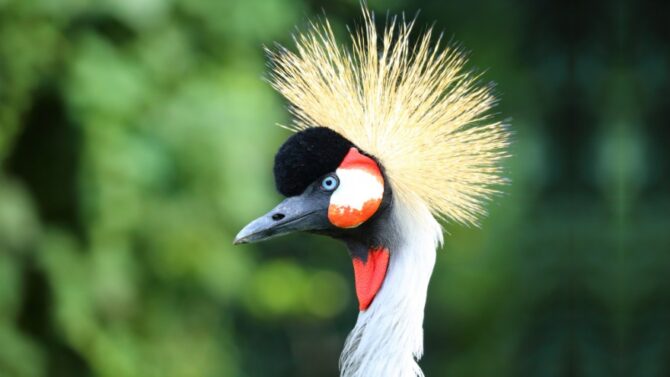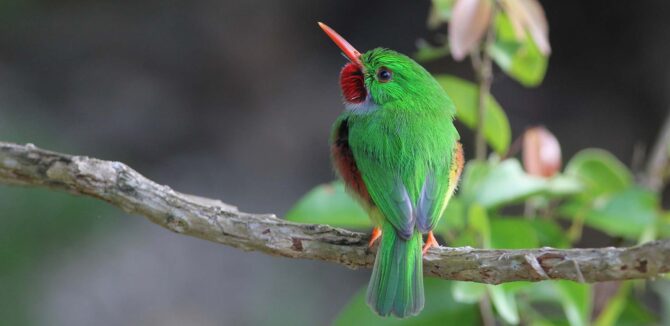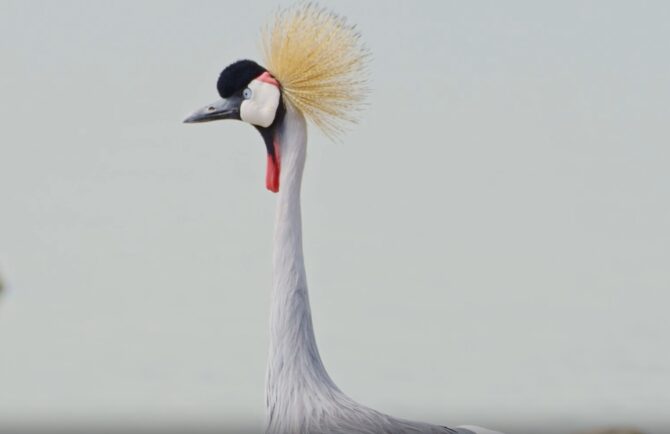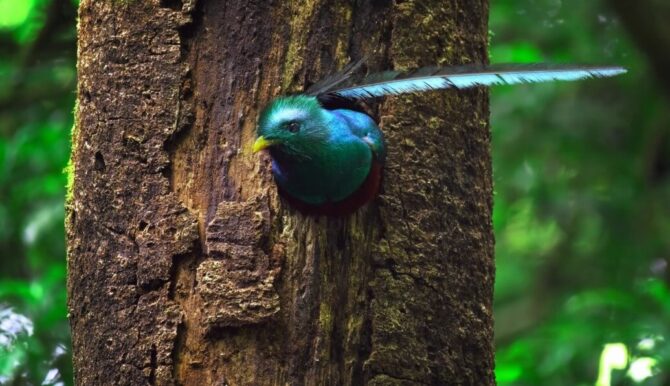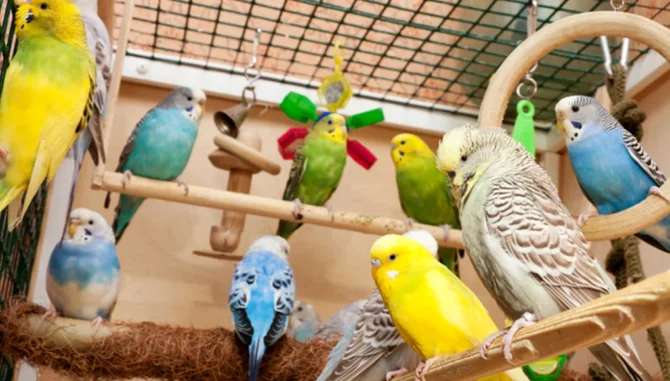Africa is home to a wide variety of amazing birds, many of which can be seen on a safari adventure.
From the majestic flamingos of the Rift Valley lakes to the colorful parrots of the rainforests, there is no shortage of fascinating avian species to discover on the continent.
In this article, we will take a closer look at 30 of the most amazing safari bird species found in Africa.
From the iconic ostrich to the endangered African penguin, these birds are sure to delight and inspire nature lovers of all ages.
So come along with us as we explore the incredible world of African birds.
30 African Birds and Where to See Them
1. Flamingo
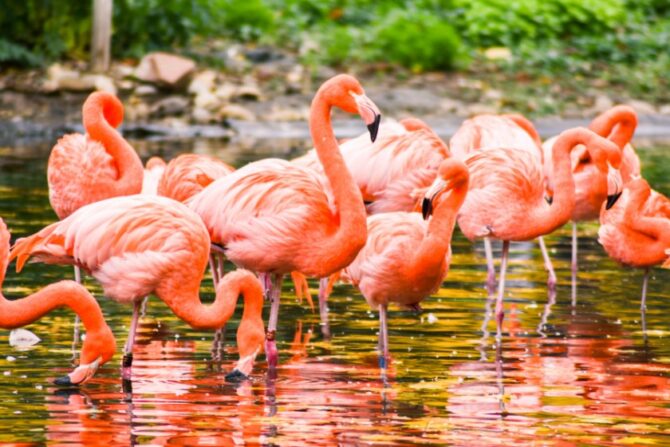
- Scientific Name: Phoenicopteridae
- Length: 4 to 5 feet
- Weight: 4 to 8 pounds
- Wingspan: 37 to 59 inches
- Identifying Features: Pink plumage, long legs, black bills
- Range: Americas, Europe, Africa, Asia
- Conservation Status: Not Extinct
The first bird on our list of safari birds is the attractive flamingo. There are four species in the world. In Africa, you’ll find the greater flamingo and the lesser flamingo.
This bird is one of the must-sees when visiting Africa. A group is called a flamboyance, a reasonable name.
The flamingo is easily recognized by its predominantly pink feathers sitting on long, thin legs.
For some reason—perhaps warmth—flamingoes usually stand with one leg, and the other remains tucked in their bodies. Their legs are webbed.
The pink color is caused by the shellfish these birds eat. Flamingoes feed on these shellfish, as well as small insects and even algae. They feed by filtering their prey from the mud they scoop.
Best Places to See the Flamingo:
- Lake Natron, Tanzania
- Lakes Bogoria, Nakuru & Elmenteita, Kenya
- Kamfers Dam, South Africa
2. Vulture
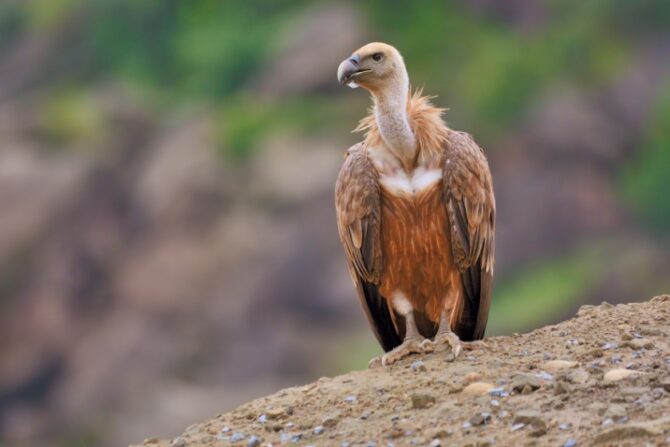
- Scientific Name: Ornithurae
- Length: 30 inches
- Weight: 15 to 33 pounds
- Wingspan: 6 feet
- Identifying Features: Bald head, black plumage
- Range: Europe, Asia, Africa, the Americas
- Conservation Status: Not Extinct
The bald bird with an unappealing look, the vulture has always had a bad reputation. Nevertheless, it is a sight to behold.
Many birdwatchers would love to get a glimpse of the vulture because of its size and unusual looks.
The vulture belongs to the Ornithurae clade, with over 23 extant species. Those living in Africa are Old World vultures.
The plumage is usually black, but the biggest identifying trait is the bald head. Vultures have no feathers on their head and neck.
These birds are scavengers and feed on dead meat, hence their bad reputation. Sighting them means there’s dead meat close by.
Groups of vultures have different names. Feeding ones are called ‘wake,’ while a group in flight is termed a ‘kettle.’ When a group is found perched on a tree, it is called a ‘committee.’
Best Places to See the Vulture:
- Savanna areas of countries like Tanzania, Namibia, Kenya
3. Pelican
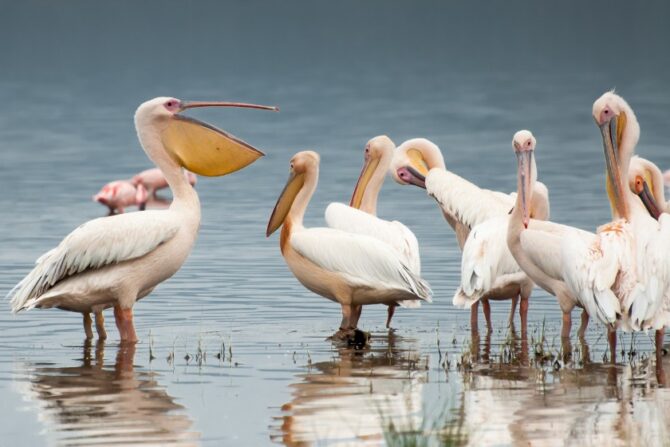
- Scientific Name: Pelecanus
- Length: 5.2 to 5.9 feet
- Weight: 22 to 26 pounds
- Wingspan: 8.9 to 10.5 feet
- Identifying Features: Large throat pouch, long beak, pale plumage
- Range: Worldwide
- Conservation Status: Not extinct
The pelican is the common name for a genus of water birds that all fall under the Pelecanidae family.
There are eight species under the genus, and they occur in all continents except Antarctica. The species living in Africa are the great white and the pink-backed pelicans.
The biggest identifying trait of the pelican is the large throat pouch which gives the impression that the bird carries something in its bill.
The latter is long, another recognizable feature. The pelican is also large, with a long neck and short legs.
The throat pouch helps it filter feed, and it scoops up fish using the throat. The pelican is closely related to the shoebill.
Best Places to See the Pelican:
- Southern Africa
- Sub-saharan Africa
4. Marabou Stork
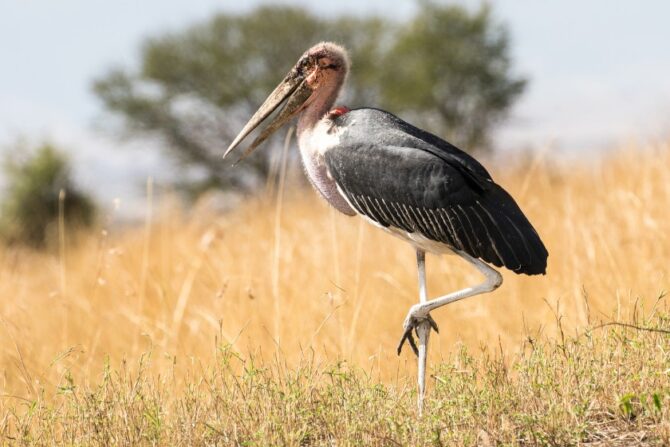
- Scientific Name: Leptoptilos crumenifer
- Length: 4.99 feet
- Weight: 20 pounds
- Wingspan: 12 feet
- Identifying Features: Bare head and neck, white underparts
- Range: Sub-saharan Africa
- Conservation Status: Least Concern
The Marabou stork is native to Sub-saharan Africa, and it belongs to the stork family named Ciconiidae.
It is similar to the vulture, and it was nicknamed the undertaker bird because of its traits.
This bird is large, with a wingspan more than the tallest human. The undertaker moniker stems from its wings and back that look like a cloak.
Added to these are the white legs and hair. Like the vulture, it has a bald head and neck.
Best Places to See the Marabou Stork:
- Safaris in Tanzania, Ethiopia, Uganda, and Kenya
5. Common Ostrich
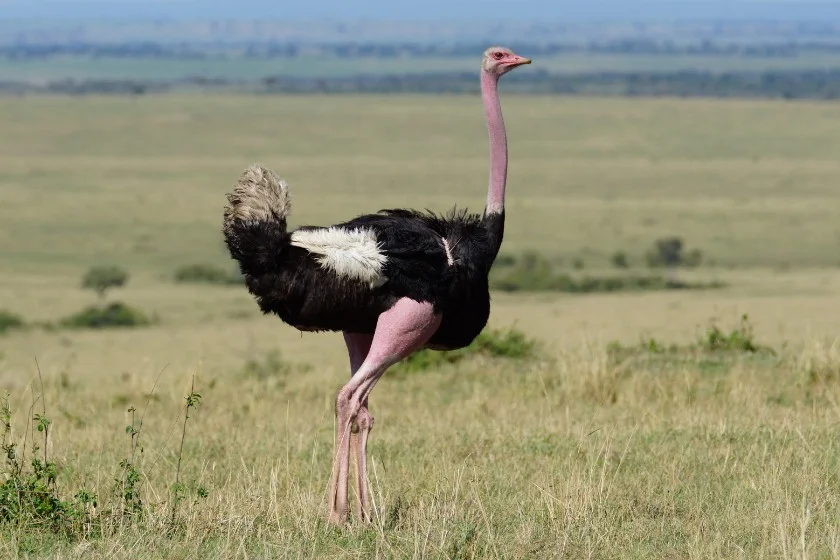
- Scientific Name: Struthio Camelus
- Length: 5 ft 7 to 9 ft 2 inches
- Weight: 139 to 320 pounds
- Wingspan: 2m
- Identifying Features: Black and white plumage, long legs, short bill
- Conservation Status: Least Concern
The common ostrich is a native of Africa and is considered the largest living bird in the world.
The common ostrich is one of two species still in existence, the other being the Somali ostrich.
This bird also has the record for the largest egg, and it is also the fastest moving, getting up to 34 mph.1
You can’t miss the ostrich when you see it. It is tall, proud-looking, and has an outstanding black plumage, though the tail and wings are white.
The long legs are neck are pale. The neck helps keep its head up while it runs.
The common ostrich feeds on both plants and small animals like insects.
Best Places to See the Common Ostrich:
- Ostrich farms, South Africa.
- Grasslands and savannahs in North and East Africa
6. Shoebill
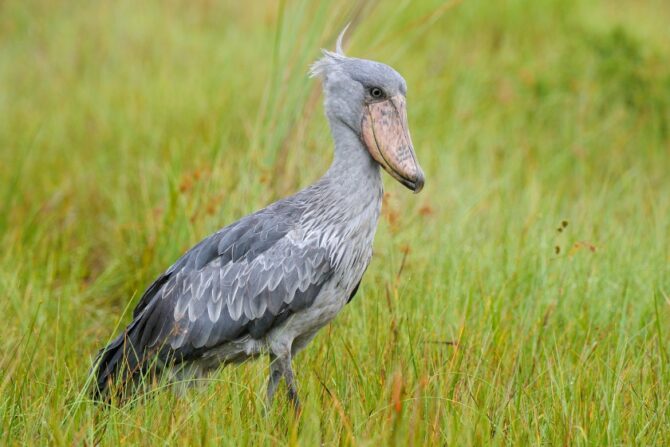
- Scientific Name: Balaeniceps rex
- Length: 43 to 55 inches
- Weight: 8.8 to 15.4 pounds
- Wingspan: 7 ft 7 to 8 ft 6 inches
- Identifying Features: Blue-grey plumage, grey head, long legs, shoe-shaped bill.
- Range: East Africa
- Conservation Status: Vulnerable
The shoebill also goes by other names like the whalebill, the shoe-billed stork, or the whale headed. It resembles the dinosaurs of old, which makes it unique.
Some people consider the shoebill to be scary, but for others (especially dinosaur fans), it is a favorite.
It is termed the shoebill due to the bill that’s shaped like a shoe. This is its most defining trait.
It also comes with long legs, with a predominant grey on the adult. Juveniles are browner. Overall, the shoebill looks like a relic from prehistoric times.
The Shoebill is a solitary bird, feeding on snakes, fish, and frogs. It inhabits marshy areas where it can stay unmoving for hours.
It is classified as vulnerable due to factors like habitat destruction and hunting.
Best Places to See the Shoebill:
- Freshwater swamps in Central and East Africa.
7. Grey Crowned Crane
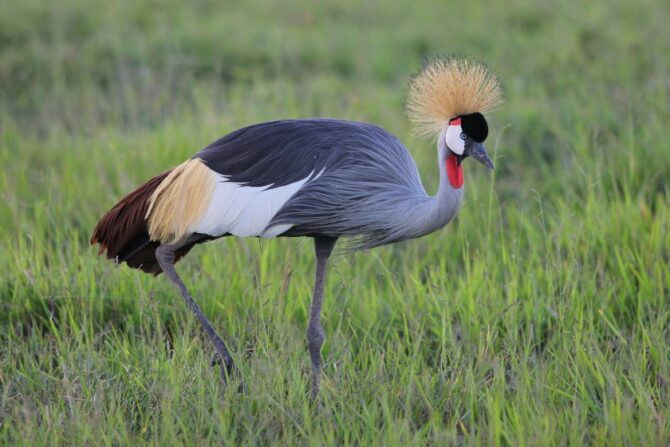
- Scientific Name: Balearica regulorum
- Length: 3.3 feet
- Weight: 7.7 pounds
- Wingspan: 6.5 feet
- Identifying Features: black legs, grey bill, and plumage, golden crown feathers
- Conservation Status: Endangered
The grey-crowned crane is found in different parts of Africa, like Congo, Kenya, South Africa, and Uganda. It is the national bird of the latter, showing its relevance in its range.
The grey-crowned crane can also be called the African crowned crane, golden-crested crane, etc.
As its name implies, the main color of this bird is grey, both on the plumage and beak. Grey isn’t the only color, however.
The wings are white, and there’s an overt golden crown sitting on its head. The face also sports a white color, while the legs are thin and black.
The grey-crowned crane is an omnivore, feeding on both plants and animals.
Best Places to See the Grey Crowned Crane:
- Mixed wetlands
- Grasslands (both in Eastern and Southern Africa)
Also See: 30 Beautiful Birds With Mohawks (With Pictures & Facts)
8. Hornbill
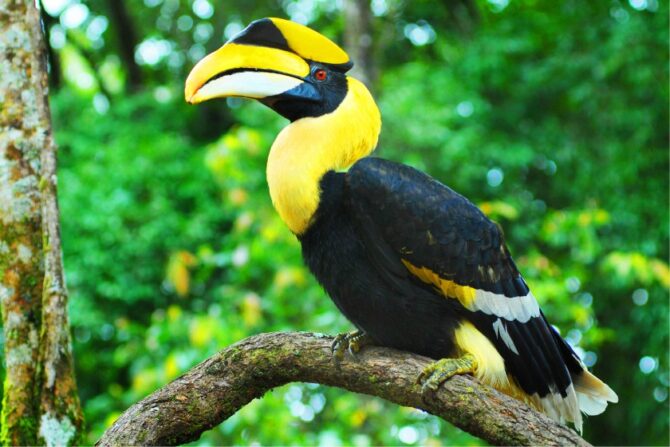
- Scientific Name: Bucerotidae
- Length: 1 ft 1 to 5 ft 11 inches
- Weight: 3.50 ounces to 14 pounds
- Wingspan: 59 to 70 inches
- Identifying Features: Long beak
- Range: Africa, Asia
- Conservation Status: Not extinct
The hornbill is a family of birds usually found in Africa and Asia. It inhabits tropical and subtropical areas, which is why the African-themed Lion King had a hornbill in it.2
It got its name thanks to the curved, multicolored bill. Because the bill is heavy, hornbills have their first and second neck vertebrae fused to help carry it. They are the only bird with this structure.
There are different hornbill species, each with its size. The bill is their common feature, but they share other similarities like the plumage that’s usually black, brown, white, or grey.
The bill is an asset as these birds use it to catch prey, fight and construct nests. Males are usually bigger than females, but this depends on the species.
Best Places to See the Hornbill:
- Savannah in Eastern and Southern Africa
9. African Penguin
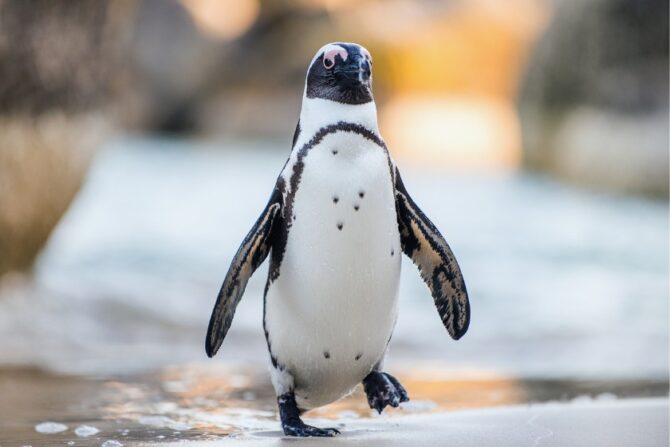
- Scientific Name: Spheniscus demersus
- Length: 24 to 28 inches
- Weight: 4.9 to 7.7 pounds
- Identifying Features: Black and white skin, pointed beak, black stripes, and spot on chest
- Range: Southern Africa
- Conservation Status: Endangered
The African Penguin is found only in Africa, specifically the southern African waters. Other penguin species are in different regions of the world.
All penguins can’t fly, and the African penguin is not an exception. They are also able to survive both on land and in the waters (though they can’t stay in water for long.)
This species is one of the African birds that needs no detailed introduction.
Many folks can recognize the penguin with ease. Its upper part is colored black, but the inner part is white.
On the chest are black and white stripes, the equivalent of a human’s fingerprints. It has loud vocals, leading to the nickname “jackass penguins.”
While this is not the typical safari bird, African penguins are worth looking for. They’re friendly towards humans, attracting many tourists.
They used to be more widespread but are now classified as endangered.
Best Places to See the African Penguin:
- South Africa
- Namibia
10. African Barbet
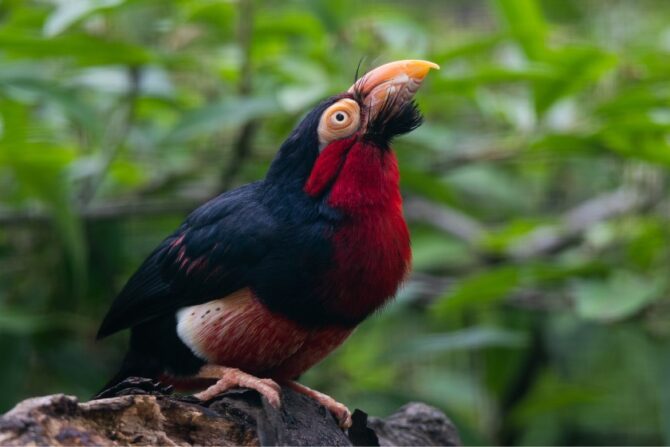
- Scientific Name: Lybiidae
- Length: 7.9 to 9.8 inches
- Weight: 0.3 to 7.2 ounces
- Wingspan: 4 inches
- Identifying Features: Large head, heavy bill
- Range: Sub-saharan Africa
- Conservation Status: Not extinct
The African Barbet refers to birds in the Lybiidae family, with 43 species in total. These birds are found in Sub-saharan Africa, except in some parts of South Africa.
The African Barbet is related to the toucan but is the smaller of the two.
The African Barbet’s prominent feature is its big head. Added to the head are the short, thick bill and a plump body.
The bill comes with bristles. A species you can easily find is the crested barbet, nicknamed the fruit salad.
This bird is solitary and would hardly be seen moving in groups. It is an omnivore, feeding on fruits and insects.
Best Places to See the African Barbet:
- Woodlands or scrub savannas in Zambia, Angola, and other Southern African countries.
11. Sunbird
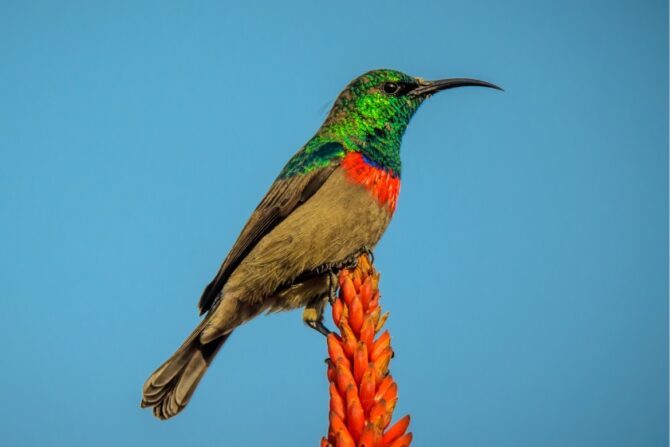
- Scientific Name: Nectariniidae
- Length: 4 inches
- Weight: 5 to 45g
- Identifying Features: Iridescent colors, thin curved bills
- Range: Africa, Asia, Australia
- Conservation Status: Not Extinct
The sunbird is a small, colorful bird that many bird lovers consider one of their favorites.
145 species make up 16 genera, and they all are part of the Nectariniidae family. Sunbirds are similar to both hummingbirds and honeyeaters.
The sunbird portrays a sexual dimorphism as the males and females are widely different.
The male sunbird is colorful, while his female counterpart is drabber. Males are also larger. Both genders have thin, curved bills.
The sunbird feeds on nectar but can also eat insects, especially when it has young ones to feed.
Best Places to See The Sunbird:
- Tropical regions of Sub-saharan Africa
12. Cattle Egret
- Scientific Name: Bubulcus ibis
- Length: 18 to 22 inches
- Weight: 9.5 to 18 ounces
- Wingspan: 34.5 to 38 inches
- Identifying Features: sturdy yellow bill, short, white plumage
- Range: Worldwide
- Conservation Status: Least Concern
The cattle egret is part of the heron family, and it was once only found in Africa, Asia, and Europe.
However, it has since spread to other parts of the world. The cattle egret is so named because it is usually found around herds of cattle.
The cattle egret has two subspecies named the western cattle egret and the eastern. Some experts consider them as separate species.
This bird is white during the non-breeding season. When breeding, some individuals develop orange buff plumes on the crown, back, and breast areas.
The bill also changes during the breeding season, becoming red instead. Males and females are similar.
The cattle egret is usually quiet but is known to make a throaty sound that goes like rick-rack.
Best Places to See the Cattle Egret:
- Lakes and marshy areas
- Safaris
13. Oxpecker
- Scientific Name: Buphagus
- Length: 7.9 inches
- Weight: 2 ounces
- Wingspan: 7-8 inches
- Identifying Features: Red eyes, short legs, long stiff tails
- Where Found: Sub-saharan Africa
- Conservation Status: Not Extinct
The oxpecker refers to two species that are under the genus Buphagus. These two species are the yellow-billed and the red-billed oxpeckers, both distinguished by their bill colors.
They earned the name oxpecker from perching on large mammals to pick off ticks, small insects, and other tiny creatures of the mammal.
While the relationship seems symbiotic as both benefit, sometimes it becomes parasitic as the bird can pick off the flesh of the animal.
These species are endemic to Africa, specifically the Sub-saharan regions. It has a greyish plumage, red eyes, short legs, and a strong, stiff tail.
Best Places to See the Oxpecker:
- Savannas in countries like Ethiopia, Kenya, Tanzania, Somalia
14. Tawny Eagle
- Scientific Name: Aquila rapax
- Length: 65 to 72 cm
- Weight: 3.5 to 6.6 pounds
- Wingspan: 5 ft 2 to 6 ft 3 inches
- Identifying Features: Brown plumage, long wings
- Range: Africa, Asia
- Conservation Status: Vulnerable
The tawny eagle is a large bird of prey that belongs to the family Accipitridae, and you’d often find it in dry habitats like deserts, steppes, or savanna plains.
It is spread in many parts of Africa and extends towards some areas in Asia.
The tawny eagle is often described as ‘inelegant’ and ‘scruffy looking’. It comes with a long neck, deep bill, and plumage that is brown.
The bill is black, and the head is a lighter shade of brown. Both organs are strong. Completing the physical traits are the long wings and tail.
These birds are opportunistic predators, sometimes going as far as stealing another animal’s game. It also scavenges on dead carrion.
However, this doesn’t mean that the tawny eagle is a weak hunter. On the contrary, the tawny eagle is a strong predator.
Best Places to See the Tawny Eagle:
- East Africa (Kenya, Tanzania, DR Congo)
- South Africa (Zimbabwe, Botswana)
15. African Wood Owl
- Scientific Name: Strix woodfordii
- Length: 12.0 to 13.8 inches
- Weight: 8.5 to 12.3 ounces
- Wingspan: 31.4 inches
- Identifying Features: White eyebrows, dark-rimmed eyes, a pale facial disc
- Range: Sub-saharan Africa
- Conservation Status: Least Concern
The African wood owl is also called the Woodford’s owl, and it is found in Sub-Saharan Africa.
In looks, it is similar to the tawny owl and the great grey owl. While in Africa, owls aren’t well received, there are over 30 species of them thriving on the continent. This includes the wood owl.
The wood owl is predominantly brown and comes with a round head that characterizes many owls.
The underparts are white with brown bars, and it is medium-sized overall. The bird gives a classical hoot, usually as a duet between the male and the female.
Best Places to See the African Wood Owl:
- DR Congo
- South Africa
- Zambia
- The Gambia
16. Superb Starling
- Scientific Name: Lamprotornis superbus
- Length: 7.1 to 7.5 inches
- Weight: 2.5 to 3 ounces
- Wingspan: 30cm
- Identifying Features: Pale yellow eyes, black face, black beak, colorful plumage
- Conservation Status: Least Concern
The superb starling formerly went by the scientific name Spreo superbus, but it now has a different one.
It is a native of East Africa, where it inhabits different habitats like savannas, woodlands, and gardens.
You’d recognize them as little birds hopping around, searching for food. They are quite attractive with their iridescent blue to green plumage on a small, robust body.
The adults have black head and nose, while the juvenile is less colorful. This bird’s eyes are yellow.
Like many other small birds, the superb starling feeds on small animals like worms, termites, and beetles.
Best Places to See the Superb Starling:
- Sub-saharan Africa
17. Secretary Bird
- Scientific Name: Sagittarius serpentarius
- Length: 3 ft 7 to 4 ft 11 inches
- Weight: 8.2 to 9.4 pounds
- Wingspan: 6 ft 3 to 6 ft 11 inches
- Identifying Features: Long legs, white and black plumage
- Conservation Status: Endangered
The secretary bird is so named because of its long, elegant legs and almost feminine figure.
It is found only in Africa, where it lives in open grasslands and the savanna. The secretary bird is large and terrestrial, though it can fly.
It isn’t hard to spot this bird as it stands out. With their long legs, head similar to that of an eagle, and black-and-grey plumage, secretary birds represent both uniqueness and elegance.
The adult’s face is colored red and orange, and it comes with long eyelashes. Males and females are similar in looks.
The secretary bird feeds on both insects and small vertebrates, stomping on the targeted prey to kill it.
Best Places to See the Secretary Bird:
- Open grasslands and savannah of the Sub-saharan region.
18. African Fish Eagle
- Scientific Name: Haliaeetus vocifer
- Length: 63 to 77 cm
- Weight: 2.1 to 3.6 kg
- Wingspan: 2 to 2.4m
- Identifying Features: Brown body, white head, dark brown eyes
- Conservation Status: Least Concern
The African fish eagle is also known as the African sea eagle, and it is the national bird of Zambia, Zimbabwe, Namibia, and Malawi.
It is spread throughout sub-Saharan Africa, which explains why it has different names in other languages. Examples are aigle pêcheur in French and Vis Arend in Afrikaans.
In looks, the African fish eagle is similar to the bald eagle, though both do not live on the same continent. Both birds have white heads, brown plumage, and yellow beaks.
The female fish eagle is bigger than the male, but other than that, there are few differences between the sexes.
As a typical bird of prey, the African fish eagle is carnivorous. It feeds mainly on fish, as the name rightfully shows.
The diet isn’t limited to fish, though. The African fish eagle also feeds on other birds, turtles, baby crocodiles, etc.
Best Places to See the African Fish Eagle:
- Lake Victoria in Uganda, Kenya, and Tanzania
19. Helmeted Guinea Fowl
- Scientific Name: Numida meleagris
- Length: 21 to 23 inches
- Weight: 2.9 pounds
- Wingspan: 59 to 71 inches
- Identifying Features: Helmet-like head, dark grey body
- Conservation Status: Least Concern
The helmeted guineafowl is the only member of the genus Numida and is recognized by its head shape.
It is mainly found close to the Sahara in Africa, but domesticated individuals have been introduced into countries like Brazil, Europe, North America, and Australia.
Its plumage is grey-black with touches of white, and the head lacks feathers like other guinea fowls.
Additional features include short and round wings, an equally short tail, and the head are of a small size.
The helmeted guineafowl feeds on a variety of animals and plants like corn, tubers, and many invertebrates.
Best Places to See the Helmeted Guinea Fowl:
- Grasslands
- Savanna
20. Lovebirds
- Scientific Name: Agapornis
- Length: 5 to 7 inches
- Weight: 1.5 to 2 ounces
- Wingspan: 24cm
- Identifying Features: Hooked bill, stocky build, short, blunt tail.
- Conservation Status: Least Concern
The lovebird is any bird that forms the genus Agapornis. Nine species form this genus and all nine lives on the African continent.
These birds are so named because of their monogamous pair bonding trait, and the pair can stay together for a long period. That’s why the name is also used for romantic couples.
Lovebirds are small in size, and their stocky build adds to make them look adorable.
What’s more, they come in green combined with any other color to make them attractive. The additional color depends on the species.
These creatures can easily bond with humans, provided you give them gentle handling. If roughly handled they get aggressive, small as they are.
These birds make good companions but avoid the wild ones. Best to get one already in captivity.
Best Places to See the Lovebird:
- Equatorial and southern Africa
21. Pied Kingfisher
- Scientific Name: Ceryle Rudis
- Length: 9.8 inches
- Weight: 1.5 to 2 ounces
- Wingspan: 24cm
- Identifying Features: black-and-white plumage,
- Range: Africa, Asia
- Conservation Status: Least Concern
The pied kingfisher is one of many kingfisher species. Kingfishers are spread worldwide and are distributed in every continent except Antarctica.
In Africa, the kingfisher species you’d find is the pied kingfisher. The pied kingfisher itself has five subspecies.
The best way to recognize this bird is by its black-and-white plumage. You’re also likely to find it hovering over lakes and rivers, searching for fish, which explains its name.
Other features include the bars on its upper parts and a long beak.
These are very vocal creatures, and you’d hear them around the lakes.
Best Places to See the Pied Kingfisher:
- Murchison Falls National Park, Uganda
22. Red-throated Bee Eater
- Scientific Name: Merops bulocki
- Length: 8 to 9 inches
- Weight: 23g
- Identifying Features: Red throat, blue belly, green upperparts, long tail
- Conservation Status: Least Concern
The red-throated bee-eater is spread throughout tropical Africa, and you can find them in countries like Uganda, Nigeria, Benin Republic, Ivory Coast, Gambia, and Togo, among many others.
In its range, the red-throated bee-eater has some preferred habitats. It stays in savannahs, farmlands, marshes, gardens, and bushy pastures. Trees are important for survival and shelter.
This bird’s name is gotten from the red throat, one of its identifying features. It also comes with a long tail, green upper parts, and a belly that’s both orange and blue.
Best Places to See the Red-Throated Bee Eater:
- Tropical regions
23. Hamerkop
- Scientific Name: Scopus umbretta
- Length: 22 inches
- Weight: 17 ounces
- Wingspan: 37 inches
- Identifying Features: Long legs, dark brown plumage
- Range: Africa, Arabia
- Conservation Status: Least Concern
The hamerkop is the only species in the genus Scopus and the Scopidae family. It is closely related to the pelicans and the shoebills.
The hamerkop is distributed amongst Africa and the Arabian peninsula, and a good place to find it is in Madagascar.
The first identifying feature of the hamerkop is the predominant brown color. The head with its bill and the crest resembles a hammer, which explains the name.
It also has a barred tail, black legs, and big wings. Something unique about the hamerkop is the partially webbed feet.
Best Places to See the Hamerkop:
- Entebbe Botanical Garden, Uganda
24. Kori Bustard
- Scientific Name: Ardeotis kori
- Length: 3 ft 5 to 4 ft 5 inches
- Weight: 15 to 40 pounds
- Wingspan: 7 ft 7 to 9 ft 7 inches
- Identifying Features: Large head, long legs, grey and brown plumage
- Conservation Status: Near Threatened
The kori bustard is a native of Africa and is a member of the bustard family.
It is the largest in its range, and the male is arguably the heaviest flying animal in the world. The kori bustard is a must-see.
Though it can fly, the kori bustard stays a lot more on the ground. The two main colors that you’d find on this creature are brown and grey.
To supplement this, it has black and white patterns. Both the eyes and legs are yellow. Males are similar to females, except that females are smaller.
Best Places to See the Kori Bustard:
- Etosha National Park, Namibia
- Kruger National Park, South Africa
25. Black-headed Weaver Bird
- Scientific Name: Ploceus melanocephalus
- Length: 6 to 7 inches
- Weight: 36g
- Wingspan: 8 to 15 inches
- Identifying Features: Black head, bright yellow bodies
- Conservation Status: Least Concern
The Black-headed weaver bird is a bird species of the Ploceidae family, and it is also known as the yellow-backed weaver.
It is distributed across different parts of Africa, namely the East, West, and Central regions. There are over 60 weaver species, a lot of which are in Sub-saharan Africa.
This particular weaver has a black head as its biggest identifying feature, which explains its name. It also has a yellow collar and equally yellow legs.
To complete this is the green plumage. Females and non-breeding males are different as they don’t have the black mask the breeding male has.
Best Places to See the Black-headed Weaver Bird
- Riverbanks and shores
26. Lilac-Breasted Roller
- Scientific Name: Coracias caudatus
- Height: 14.5 inches
- Weight: 110g
- Wingspan: 50 to 58cm
- Identifying Features: lilac throat, colorful plumage
- Conservation Status: Least Concern
The lilac-breasted roller is a small, beautiful bird that is spread across the eastern and southern parts of Africa.
It also goes by other names like fork-tailed roller, lilac throated, and Mosilikatze’s roller. These birds draw a lot of admirers because of their looks.
The lilac-breasted roller is designed with different colors, from lilac on the throat and breast to blue and olive spread on other parts of its plumage.
It is considered one of the most beautiful birds in Africa for good reasons.
The bird isn’t peaceful, however. The lilac-breasted roller is very territorial, even fighting off bigger birds.
Best Places to See the Lilac-Breasted Roller:
- Open woodlands
- Bushy savannahs
27. African Sacred Ibis
- Scientific Name: Threskiornis aethiopus
- Length: 27 inches
- Weight: 3 to 3.3 pounds
- Wingspan: 44 to 49 inches
- Identifying Features: bald head, curved bill, white wings
- Range: Africa, Asia
- Conservation Status: Least Concern
The African sacred ibis is a wading bird of the Threskiornithidae family, and it is found mainly in Africa.
It isn’t limited to the African continent, however, as some individuals live in Iraq, Kuwait, and Iran.
This bird is called “sacred” because of its association with the Egyptian god Thoth.
The plumage is white, but the rear borders are colored black. The bill, legs, neck, and bald head are also black.
Males and females are similar in looks, but the males are slightly bigger.
These birds are quiet creatures, but you’d recognize they’re around by their puppy-like sound.
Best Places to See the African sacred ibis:
- North Africa
- Sub-saharan Africa
- Ystad, Sweden
28. Yellow Billed Stork
- Scientific Name: Mycteria ibis
- Length: 35 to 41 inches
- Weight: 4.2 to 5.1 pounds
- Wingspan: 150 to 165 cm
- Identifying Features: white plumage, yellow bill, bright red facial skin
- Conservation Status: Least Concern
The yellow-billed stork belongs to the Ciconidae family, and it is also called the wood stork or the wood ibis.
It lives specifically in Madagascar and the Sahara regions. As the name clearly shows, the yellow-billed stork has a yellow bill, which is its outstanding trait.
Besides the yellow bill, you’d recognize this bird by its white plumage, black tail, and brown legs.
The tail takes on a green and purple color when molted while the legs and plumage become pink during the breeding season.
Best Places to See the Yellow-Billed Stork:
- Freshwater wetlands and lakes in Eastern and Southern Africa.
- Madagascar
29. Saddled Billed Stork
- Scientific Name: Ephippiorhyncus senegalensis
- Length: 4 ft 8 inches
- Weight: 11 to 16.6 pounds
- Wingspan: 7 ft 10 to 8 ft 10 inches
- Identifying Features: long thin legs, slender neck, colorful beak
- Conservation Status: Least Concern
The saddled-billed stork is a member of the Ciconidae (stork) family, and it lives in different parts of Africa.
In South Africa, it is an endangered species, but in other places, the saddled-billed stork is safe. It is closely related to the black-necked stork.
The saddled billed is a mixture of white, black, red, and orange on different parts of its body.
It is named after the colorful bill that looks like a saddle. The saddled-billed stork is the tallest in the world, surpassing even the marabou. The latter only has more weight.
Best Places to See the Saddled billed Stork:
- South Africa
- Sub Saharan Africa
30. Swamp Flycatcher
- Scientific Name: Muscicapa aquatica
- Length: 13cm
- Weight: 0.49 to 0.71 ounce
- Identifying Features: Brown plumage
- Conservation Status: Least Concern
The last on our list of birds of Africa is the swamp flycatcher, a member of the Muscicapidae.
It is spread around Africa in countries like Benin Republic, Cameroon, Burundi, Gambia, Ghana, and Zambia. In these countries, you’d find it around shrublands and swamps.
This bird can be hard to spot because of its size, so the best place way is to navigate its natural habitats.
Its predominant color is brown, darker on the upper parts and lighter underneath. As the name goes, the swamp flycatcher feeds on flies and other insects.
Final Thoughts: Safari Birds are a Sight to Behold
Africa is a continent filled with a variety of animals and the necessary habitat for them. So, while you go after amazing African safari animals on your next adventure, look out for the birds too!
There are over 2500 bird species, making Africa a haven for birdwatchers.
Our list of African birds is a great place to start, and you can do further research on the species that most interests you.
Whether you are an avid birdwatcher or just appreciate the beauty of these amazing creatures, a safari in Africa is an unforgettable experience that offers the opportunity to see some of the most fascinating and unique birds on the planet.
So pack your binoculars and get ready to explore the incredible world of safari birds.
References & Notes
Facts Sources:
- Largest egg from a bird (living, specimen). Guinness World Records.
- Zazu. Fandom.
